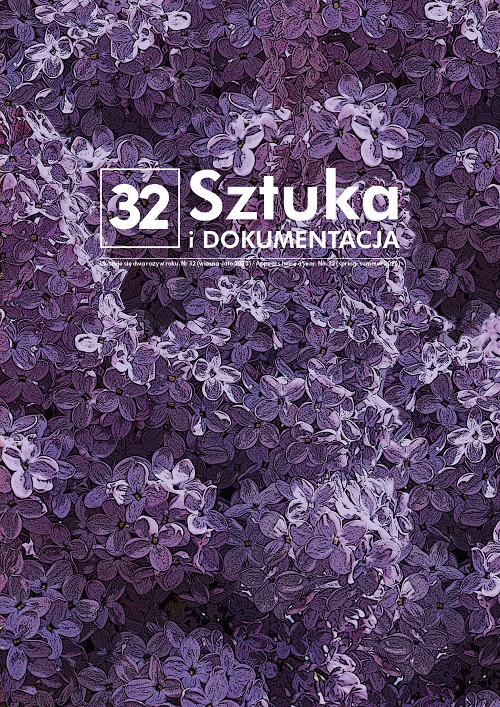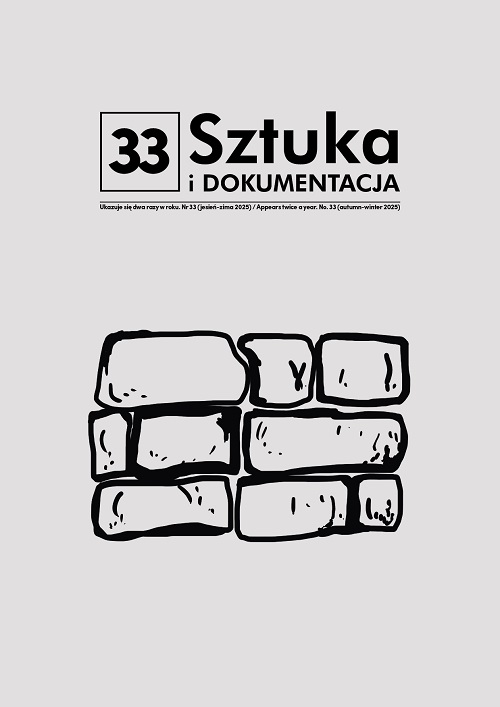|
ART&DOCUMENTATION - general information about the content / materials in process
Call for articles
submit your proposal to:
email: journal@doc.art.pl
|

Sztuka i Dokumentacja nr 32 / Art and Documentation no. 32
Spis Treści / Table of Contents
Roman NIECZYPOROWSKI, Franciszek Duszeńko w świetle badań archiwalnych / Franciszek Duszeńko in the light of archival research
Sekcja / Section
Images for the Politics of the Future
Edited by Łukasz GUZEK / Introduction by the Editor
Marina GRŽINIĆ, In the Aftershock of Insurgent Flows. Trans*Decolonial and Black Marxist Futures
Anahita NEGHABAT, Fluid Interconnections: On the Film Insurgent Flows by Gržinić, Kancler, Pristovšek (2023)
Maša GUŠTIN, Art on the Edge in Theory and Practice: Marina Gržinić, NECROREALISM, and Retro-Avant-Garde
Janusz CZECH, "Second-Class" Citizen Positions and the Works of Gržinić/Šmid. A Sea of Traumatized Souls Stuck in the Post-socialist Era
Jacek KOŁTAN, Późna emancypacja późnej nowoczesności. Protesty kobiet w czasie nieliberalizmu / Late emancipation in late modernity. Women's protests in times of illiberalism
VARIA
Marta MIASKOWSKA, Lustro obiektywu. Strategie artystycznej obecności w polskiej sztuce nowych mediów / The mirror lens. Strategies of artistic presence in Polish new media art
Patrycja IGNACZAK, Pop-art i Poetyka Traumy / Pop Art and the Poetics of Trauma
Grażyna SZCZEŚNIAK, Obraz Trójwymiarowy / Three-dimensional Painting
Łukasz GUZEK, Grzegorz Sztabiński: Trzy Pojęcia i Rama / Grzegorz Sztabiński: Three Concepts and the Frame
DOKUMENTACJA / DOCUMENTATION
Cornelia LAUF, Islamic Arts Biennale in Jeddah: A View from Rome
Lenka KLODOVÁ & Karolína RAIMUND, Made by Nudity: Docufashion Project by Festival of Naked Forms
Maria Anna POTOCKA, Jan Mlčoch w Galerii Pi i Galerii Pawilon / Jan Mlčoch at Pi Gallery Pi and Pawilon Galery
Artur TAJBER, Lawrence Weiner: LaAS LONG AS IT LASTS
BOOKS
Dorota FOLGA-JANUSZEWSKA, Aktualność Sztuki. Innowacyjna Opieka nad Sztuką Nowoczesną i Współczesną, ed. Iwona Szmelter. Warszawa: ASP w Warszawie, 2024/2025.
OBITUARY
Jan RYLKE, Przemysław Kwiek - Rzeźbiarz / Przemysław Kwiek - the Sculptor
GALERIA im. ANDRZEJA PIERZGALSKIEGO. Dokumenty Artystów 11 / ANDRZEJ PIERZGALSKI GALLERY. Artists' Documents 11 / GALERIE dédiée a ANDRZEJ PIERZGALSKI. Documents d'Artistes 11
Leszek BROGOWSKI, Edycja 11 - Założenia Programowe / Edition 11 - Program Assumptions / Édition 11 - Hypotheses du Programme
Ad Reinhardt, część 2 / Part 2
Jason E. HILL, Artist as Reporter: Weegee, Ad Reinhardt, and the PM News Picture [Artysta jako reporter: Weegee, Ad Reinhardt i obrazy aktualności w dzienniku PM]. Tłumaczenie, fragmenty.
Laurence CORBEL, Pojekcje diapozytywów i szkicowniki Ad Reinhardta.
Leszek BROGOWSKI, Sztuka jako praktyka krytyczna (Taroop & Glabel, Ernest T. i inne pseudonimy)
Laurent MARISSAL, Autoprezentacja
LJC, Dokumenty na temat claude'a rutault
Leszek BROGOWSKI, Przedsiębiorstwo "That's Painting" Bernarda Brunona

Sztuka i Dokumentacja nr 33 / Art and Documentation no. 33
Spis TrePci / Table of Contents
Sekcja 1 / Section 1
Sztuka w przestrzeni publicznej: pamięć kolektywna - pamięć indywidualna / Art in public space: collective memory - individual memory
Edited by Łukasz GUZEK and Roman NIECZYPOROWSKI
Anna REMISZEWSKA, Analiza treści symbolicznych założenia pomnikowego w Treblince
Anna Maria LEŚNIEWSKA, Poza Linią Podziału. W Dyskursie: Film i Rzeźba / Beyond the Dividing Line: In Discourse: Film and Sculpture
Barbara MAROŃ, Wyobrażenia Aktywne / Images as Agents. Dla / to Giulio Camillo
Sekcja 2 / Section 2
BOOKS
OD ESTETYKI PROCESU TWÓRCZEGO DO ESTETYKI ETHOSOFICZNEJ / FROM THE AESTHETICS OF A CREATIVE PROCESS TO ETHOSOPHIC AESTHETICS
WSTĘP / INTRODUCTION
Red. / Edit. by Grzegorz WYCZYŃSKI
Edward KAROLCZUK, Etetyka Sztuki Efemerycznej / Aesthetics of Ephemeral Art
Grzegorz WYCZYŃSKI, Wokół Estetyki Ethosoficznej Bogusława Jasińskiego. Filozofia Gry Wideo Kino / Around the Ethosophical Aesthetics of Bogusław Jasiński.
Philosophy - Video Games Cinema
Elżbieta ŁUBOWICZ, Krytyka Sztuki Jerzego Ludwińskiego a Estetyka Procesualna Bogusława Jasińskiego / Art Criticism by Jerzy Ludwiński and the Aesthetics of Creative Processes by Bogusław Jasiński
GALERIA im. ANDRZEJA PIERZGALSKIEGO. Dokumenty Artystów 12 / ANDRZEJ PIERZGALSKI GALLERY. Artists' Documents 12 / GALERIE dédiée a ANDRZEJ PIERZGALSKI. Documents d'Artistes 12
|
Informacje 'dla autorów' / Infos 'for authosrs': http://www.journal.doc.art.pl/zasady_pisania_tekstow_menu.html.
CALL FOR PAPERS
Sekcje tematyczne - otwarty nabór:
Fluxus w krajach Europy.
VARIA
KSIĄŻKI
HISTORIA RUCHU GALERYJNEGO
PROJEKTY - KOLEKTYWY - INICJATYWY
MOJA DEFINICJA SZTUKI PERFORMANCE
|
Section:
Documents of Art
Andrzej Pierzgalski (1938-2016) founded and ran the A4 Gallery in Łódź in the 1970s. A gallery dedicated to him was opened in 2012 in the Art and Documentation journal. Since 2018 the gallery has been curated by Leszek Brogowski.
After the Second World War, a rapid process of deconstruction of the traditional concept of a work of art took place: process and information replaced the material object; documents replacing the work of art referred to the working process rather than the creative act; the intellectualization of artistic processes is opposed to aesthetic fanaticism; discretion, moderation and restraint are contrasted to lavishness, spectacle and exaggeration, especially on the art market, etc. One of the most interesting places where the clear contours of the concept of a work of art have blurred, is precisely its border with the document. Yet art historians often distinguish the work of art as the proper subject of research, and accompanying documents, such as: an order, a contract for a work, a notarial document, etc., as only a material accompanying the research. In reference to many practices of contemporary art, this distinction can no longer be applied, because a work can now take the form of a document, and a document can replace a work; often these two functions overlap or coexist. In the work Document (1963), to a work inspired by Marcel Duchamp's notes, Robert Morris added the notarial act - Statement of Esthetic Withdrawal - by virtue of which he withdrew all aesthetic qualities from it; if this document is disconnected from the work of art and considered only as a supplement to it, the work of art will completely change its character. You can even ask yourself if the work of art is not just a specific document and a trace of the artistic process. The program of the Documents of Art Gallery will be focused, however, on printed documents: not on the so-called artistic prints, but on documents with industrial offset, photocopy and even hand-folded, rubber fonts, or mechanical reproduction techniques, which Walter Benjamin writes at the beginning of his essay: "The enormous changes brought about in literature by movable type, the technological reproduction of writing, are well known. But they are only a special case, though an important one, of the phenomenon considered here from the perspective of world history. In the course of the Middle Ages the woodcut was supplemented by engraving and etching, and at the beginning of the nineteenth century by lithography." [1] Well, the offset is just an improved and industrialized lithography, where the zinc plates replaced heavy lithographic stone, thus enabling mass printing of photographs. The use of industrial printing as the basis for documents of art (manifests, artistic magazines, artists' books, catalogues, leaflets, invitations, visual poetry, etc.) has become an impulse for profound changes not only in artistic practices, but also - as Benjamin predicted - in the very notion of art. Art documents presented here will therefore be an opportunity to trace the most important stages and aspects of these changes.
[1] Walter Benjamin, The Work of Art in the Age of Its Technological Reproducibility, and Other Writings on Media, edited by Michael W. Jennings, Brigid Doherty, and Thomas Y. Levin, translated by Edmund ]ephcott, Rodney Livingstone, Howard Eiland, and Others (Cambridge, Mass., London: The Belknap Press Of Harvard University Press, 2008), 20.
Submit your proposal to this Section to: Leszek Brogowski, email: leszek.brogowski@univ-rennes2.fr
|
|

